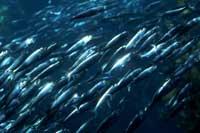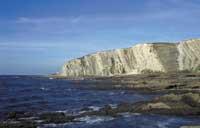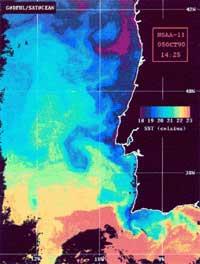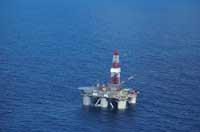A limit full of action
Oceans directly affect the earth's climate. However, its role in the overall carbon cycle is little known, among other things, for the extent of the regions to be investigated. The European Union has worked for 7 years to study the rich ecosystems of the northeastern Atlantic, identifying key processes affecting climate change.
The European Union launched the Ocean Margin Exchange (OMEX) project in 1993. The program aimed to investigate the exchange of carbon dioxide between the ocean and the atmosphere and to study its possible impact on climate change and has lasted 7 years. The project, which has received a grant of 32 million euros (5,312 million pesetas, 212 million pounds), has had the participation of 38 entities from the countries that make up the European Union and seems to have obtained interesting results.
Carbon accumulation
Oceans
cover two-thirds of our planet and play an important role in the overall carbon cycle. According to recent studies, more than a third of the carbon dioxide emitted by human activity is captured by the oceans, which reduces the accumulation of gases in the atmosphere. The oceans thus contribute to the greenhouse effect and climate change.

The
process is known: an exchange of carbon dioxide occurs between the atmosphere and the ocean. The ocean collects, accumulates and stores carbon dioxide from the atmosphere for a long time, which contributes, as has already been said, to maintaining the greenhouse effect. However, it is not very clear why this process occurs. Two hypotheses are currently being worked on. The mechanism of the former is very simple: the gas dissolves in the water of the oceans, especially in cold waters near the polar regions. The mechanism of the second, on the other hand, is called "biological bomb" and is as important as the other. According to this, phytoplankton consumes CO 2 stored on the marine surface for photosynthesis. Phytoplankton is a set of microscopic plants suspended in water that, through photosynthesis, transform carbon dioxide. They consume CO 2, release oxygen and produce food for ocean dwellers. Part of the production moves to the ocean bottoms and accumulates in the native sediments.
Thanks to this mechanism, carbon dioxide does not accumulate in the atmosphere but accumulates on the seabed.
In this
context, the continental borders of the oceans are very productive systems that the OMEX project has analyzed. Continental borders are the margins between the continental shelf and the deep ocean, with great biological activity. The continental shelf, the land we live in, does not end on the coast, remains underwater for several kilometers. Its depth increases and suddenly ends with a slope with a very violent angle. Between Europe and the Atlantic Ocean, in general, they are wide, with smooth angles and well developed slopes. The depth of the oceans is minimal, so they depend entirely on sea level changes and sea level change depends on the climate.
Complex limits

The overall
objective of the OMEX project is, therefore, to understand how the carbon cycle is at the continental borders of the oceans, that is, to check whether the hypotheses mentioned coincide with reality. Despite knowing the importance of continental borders in the marine carbon cycle, there are still many questions to answer: how carbon dioxide exchange occurs between the atmosphere and water, and how this affects the fertility of the continental shelf, for example.
The OMEX project has been developed in two phases: From 1993 to 1996 the northeast of the Gulf of Bizkaia was studied and from 1997 the northwest of the Iberian Peninsula. In the first phase the study focused on a wide platform that ended with a strong slope, while in the second phase an area of totally different characteristics was analyzed: a very narrow continental platform. Due to the sea currents, the fertile waters of the ocean floor emerge. In this way, the researchers of the OMEX project have been able to grasp the general idea of what happens on the continental shores of Europe.
Gulf of Biscay
According
to satellite images, from spring to autumn a cold water region develops in the northeast of the Bay of Biscay, which coincides with the continental boundary located 200 meters deep. Due to the large amount of salt and nutrients contained in the waters, there is a fertile production of phytoplankton, with the presence of phytoplankton and the presence of fish that make fishermen often approach. The region is therefore a very important fishing area.
In this case, researchers have analyzed the activity of phytoplankton. It seems that approximately half of the organic matter produced by them accumulates in the sediments of the seabed, both on the continental shelf and on the wall that forms the edge. It will feed or accumulate organisms that live on the seabed. To draw these conclusions, the researchers have measured the flow of gases between the marine surface and the air and have verified that the exchange is real. The "biological pump" therefore actually works and transfers atmospheric carbon dioxide to the seabed.

In addition, it has been observed that the water of the continental border is divided into layers at different temperatures. This temperature gradient causes food to be transported incorrectly from one layer to another and not to reach the sea surface. If there is little food, the activity of phytoplankton is reduced and the "biological pump" loses effectiveness. According to the researchers, water stratification is due to global warming. On a warmer planet, the "biological pump" will have less efficiency: it will consume less carbon dioxide and, therefore, the planet will heat more.
Iberia
The second phase
of the project has investigated the region of Galicia and Portugal. The region is one of the most fertile regions in Europe, as thanks to the wind that blows from the north of spring to autumn, the food of the funds emerge. Most foods are consumed by fish. On the other hand, in the rías of Vigo and Muros there is an intense aquaculture.
But despite being an area of great biological activity, its continental shelf is so narrow that most of the organic matter produced is transported to the ocean. In the Iberian region, unlike the Bay of Biscay, the accumulation of carbon on the continental shelf is low and very high on the slope and on the other side of the ridge.
Carbon dioxide exchanges between the atmosphere
and the sea surface are complex. However, it has been proven that the models developed to explain the exchanges largely coincide with the real situations, which will allow making long-term predictions. The results obtained in the OMEX project can also be extrapolated to other continental borders. In this way, we will be able to assess the importance of ocean processes in the mitigation of climate change.
Economic importance
of continental borders

Continental
borders are not only biologically and ecologically, but also economically very important, as most of the world's fisheries are concentrated in these regions. In addition, sport fishing and tourism are becoming a very important activity in industrialized countries. Therefore, continental borders are heavily exploited regions. But they are also the largest landfills in the world. At these margins all kinds of waste are accumulated and environmental and ecological pollution is enormous. Formerly the oceans were able to metabolize the garbage that we throw, today not. However, they are still used as landfills. On the other hand, continental borders are a source of minerals. Each year a ton of sand is extracted and in some places tin, gold and minerals have been found. But above all, natural gas and oil are the most precious raw materials extracted from continental borders. The oil companies operating on the continental borders have increased considerably in recent years, since in these regions oil and gas deposits could be found still to be discovered, since, due to their geological characteristics, they are suitable areas to complete this type of deposits. All this economic activity significantly affects the rich and complex ecosystem of continental borders, probably more intense than those affecting it.
Published in the supplement Natura de Gara
Buletina
Bidali zure helbide elektronikoa eta jaso asteroko buletina zure sarrera-ontzian











